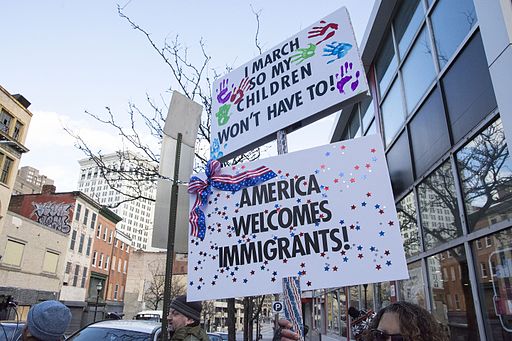 Recognizing identifications as narrative constructs or fixed identities organizes the world in particular ways that inform the debate over the immigration order that Trump issued last Friday, shutting down admission of refugees for 120 days and banning citizens of 7 predominately Muslim countries from entering the US for 90 days. Certainly, one aspect of the debate hinges on a person’s willingness to generalize an entire nationality as a threat, as some have asserted that everyone from those countries hates the United States, but these two models of identification also serve different functions in different settings.
Recognizing identifications as narrative constructs or fixed identities organizes the world in particular ways that inform the debate over the immigration order that Trump issued last Friday, shutting down admission of refugees for 120 days and banning citizens of 7 predominately Muslim countries from entering the US for 90 days. Certainly, one aspect of the debate hinges on a person’s willingness to generalize an entire nationality as a threat, as some have asserted that everyone from those countries hates the United States, but these two models of identification also serve different functions in different settings.
The rationale behind the order and arguments supporting it generally emphasizes a notion of fixed identity. Based either on national heritage or religious commitment (depending on the elements of the order and the version of the arguments considered), a person’s identity remains virtually static. Thus, whether the person has worked in the United States as a businessperson for decades or is a five-year-old citizen of the United States of Iranian heritage, they are identified as potential threats simply because of their national heritage, regardless of their experiences since their birth.
On the other side is typically a concept of narrative identification in which people continually construct their identifications from their narrativized experiences and stories that they hear from their family and community. Kicking the winning goal in their middle school soccer game, listening to the music and stories of a grandparent’s childhood in 1920’s Iran, and developing an international business with their cousins can contribute to their sense of who they are. All sorts of other events in their lives that could inform their self-identification, though, can take on a less significant place in their identity formation. Thus, certain of their experiences, both first and second hand, are more significant to their self-perception and better predictors of future actions than the national, ethnic, or religious labels that people assign them as their fixed identities.
Emphasizing the narrative identity makes the individual cases of people caught in the immigration ban untenable. People whose story has no element of potential threat have been harassed, detained, or denied entry. More significantly, the narrative identification model supports the argument that the immigration ban is counter-productive. Narratives of mistreatment, of themselves or people with whom they empathize, can shape an individual’s identification, leading to a whole range of forms of protest and resistance. While many in the United States now identify as resisters because these narrative of the immigration ban clash with the ideals of the United States that inform their individual narratives, stories of mistreatment also can contribute to a narrative identification as a member of an oppressed community, an identification that groups like ISIS target for recruitment.
A narrative conception of identifications is not as easy to implement as immigration policy; it does not allow for a simple assumption that the threats come from people from certain places or in a particular community. A conception of narrative identification also can be less comforting, as threats are not easily identifiable without fixed labels. However, the sense of security from fixed identities is illusory, as it fails in the face of various events of mass violence in the United States, ranging from Columbine to Sandy Hook to Charleston. In each of those cases, people afterwards considered the narratives and motives of the killers carefully to try to construct why this person attacked. The care of developing such constructions is a necessity for many, because attributing the violence to a fixed identity is untenable to many when the attacker is white, American, male, fixed identities that implicate too many of us and those in our communities.
Fixed identities, then, can be comforting when the threat is assumed to be from the outside, while narrative identifications are more useful psychologically when the threat is too close to home.
Photo credit: Anti Trump Immigration Protest in Baltimore 28 January 2017 by Bruce Emmerling [Public Domain], via Wikimedia Commons
